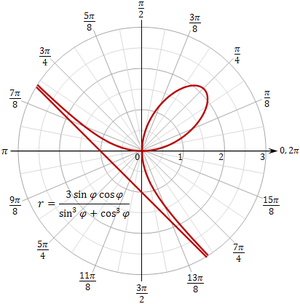
In geometry, the folium of Descartes (from Latin folium 'leaf'; named for René Descartes) is an algebraic curve defined by the implicit equation
History
[edit]The curve was first proposed and studied by René Descartes in 1638.[1] Its claim to fame lies in an incident in the development of calculus. Descartes challenged Pierre de Fermat to find the tangent line to the curve at an arbitrary point since Fermat had recently discovered a method for finding tangent lines. Fermat solved the problem easily, something Descartes was unable to do.[2] Since the invention of calculus, the slope of the tangent line can be found easily using implicit differentiation.[3]
Graphing the curve
[edit]
The folium of Descartes can be expressed in polar coordinates as which is plotted on the left. This is equivalent to[4]
Another technique is to write and solve for and in terms of . This yields the rational parametric equations:[5]
We can see that the parameter is related to the position on the curve as follows:
- corresponds to , : the right, lower, "wing".
- corresponds to , : the left, upper "wing".
- corresponds to , : the loop of the curve.
Another way of plotting the function can be derived from symmetry over . The symmetry can be seen directly from its equation (x and y can be interchanged). By applying rotation of 45° CW for example, one can plot the function symmetric over rotated x axis.
This operation is equivalent to a substitution: and yields Plotting in the Cartesian system of gives the folium rotated by 45° and therefore symmetric by -axis.
Properties
[edit]It forms a loop in the first quadrant with a double point at the origin and asymptote It is symmetrical about the line . As such, the two intersect at the origin and at the point .
Implicit differentiation gives the formula for the slope of the tangent line to this curve to be[3] Using either one of the polar representations above, the area of the interior of the loop is found to be . Moreover, the area between the "wings" of the curve and its slanted asymptote is also .[1]
Relationship to the trisectrix of Maclaurin
[edit]
The folium of Descartes is related to the trisectrix of Maclaurin by affine transformation. To see this, start with the equation and change variables to find the equation in a coordinate system rotated 45 degrees. This amounts to setting
In the plane the equation is
If we stretch the curve in the direction by a factor of this becomes which is the equation of the trisectrix of Maclaurin.
Notes
[edit]- ^ a b "Folium of Descartes". Encyclopedia of Mathematics. June 5, 2020. Retrieved January 30, 2021.
- ^ Simmons, p. 101
- ^ a b Stewart, James (2012). "Section 3.5: Implicit Differentiation". Calculus: Early Transcendentals. United States of America: Cengage Learning. pp. 209–11. ISBN 978-0-538-49790-9.
- ^ Stewart, James (2012). "Chapter 10: Parametric Equations and Polar Coordinates". Calculus: Early Transcendentals (7th ed.). Cengage Learning. p. 687. ISBN 978-0-538-49790-9.
- ^ "DiffGeom3: Parametrized curves and algebraic curves". N J Wildberger, University of New South Wales. Archived from the original on 2021-12-21. Retrieved 5 September 2013.
References
[edit]- J. Dennis Lawrence: A catalog of special plane curves, 1972, Dover Publications. ISBN 0-486-60288-5, pp. 106–108
- George F. Simmons: Calculus Gems: Brief Lives and Memorable Mathematics, New York 1992, McGraw-Hill, xiv,355. ISBN 0-07-057566-5; new edition 2007, The Mathematical Association of America (MAA)
































